Change Language :
DryLin® - Trapezoidal lead screw nut - Technical data
Classic format adjustments and lifting applications can be implemented with the self-locking trapezoidal thread. Quick adjustments or handling utilize the high ratio of the steep thread. All lead screws are available in steel or stainless steel and provide a corrosion free solution in combination with DryLin® lead screw nuts made from iglide® plastics.
Advantages of the DryLin® lead screw modules:
- Maintenance-free, dry operation
- Low noise
- Insensitive to dirt and dust
- Resistant to corrosion
- Trapezoidal thread and high helix thread
- High efficiency
- Anti-backlash function available
- FDA certification available
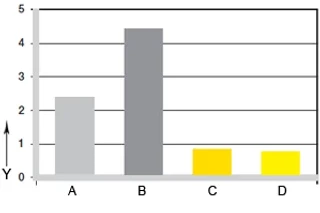
Y = Wear [Wt.-%]
A = POM
B = PA
C = J
D = L280
Fig. 01: Wear test on a rolled trapezoidal lead screw
Special features
DryLin® lead screw units operate completely maintenance and self-lubricating on a variety of lead screw materials because the nuts are made from iglide® high-performance polymers. In comparison to nuts with maintenance and lubrication requirements, these lead screw nuts provide significant advantages, especially in applications with high dust and dirt exposure (textile, rock and wood processing machinery) and in applications that include cleaning processes (packaging and foodstuff machinery).
Radial forces
DryLin® lead screw nuts are designed to absorb axial forces. Any radial forces that may occur in the application should be absorbed by additional linear guides.
Temperature
DryLin® lead screw nuts, which are manufactured from maintenance-free iglide® materials, are principally suited for use in temperatures ranging from –04 °F to +194 °F (302 °F, depending on material). However, please note that the temperature expansion causes a change in the maximum allowable load in addition to the changing clearance situation. When the application is exposed to particularly low or high temperatures and high loads, we recommend testing the suitability of the lead screw nuts for the specific case by means of empirical experiments. We have lead screw nuts available in various play classes to provide for their use in all temperature ranges.

Y = Wear [mg/km]
A = J
B = L280
C = J350
D = A180
E = POM
Fig. 02: Wear test on a C15 lead screw [mg/km] stroke 140 mm, 50 N, lead screw C15 rolled, 450 RPM
Wet area
For applications in humid environments, especially in wet area, the trapezoidal lead screw nuts made of iglide® J or iglide® A180 should be used. These materials are characterized by very low moisture absorption.
iglide® J
iglide® A180
Dirt
DryLin® lead screw units feature completely dry-running travel by exclusively using maintenance-free iglide® materials for lead screw nut production. Adhesion of soft particles such as dust and fibers is greatly reduced by deliberately eliminating lubricants. As compared to conventional, lubricated materials, it is common to see significant improvements in the service life in contaminated environments. However, the lead screw should be covered in environments with significant contamination and hard particles, such as metal chips or granite dust.
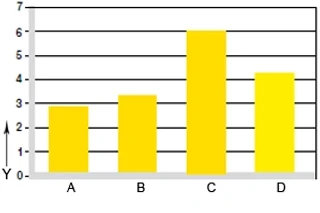
Y = Wear [mg/km]
A = J
B = L280
C = J350
D = A180
Fig. 03: Wear test on a stainless steel lead screw [mg/km] stroke 140 mm, 50 N, stainless steel lead screw, rolled, 450 RPM
Noises
Noise can generally occur with the use of gliding lead screw units. In particular, long lead screws and long travels can cause self-induced vibrations in gliding systems. Due to their good gliding characteristics, lead screw nuts made from tribologically optimized iglide® materials tend to develop much less noise than conventional plastics or metallic materials, such as bronze or brass. If your gliding lead screw unit develops noise, please contact us to discuss this with our experts.
Lead screw unit testing
DryLin® lead screw units are manufactured in accordance with DIN 103. The testing takes place by means of standardized thread plug gage after production. For thread sizes that are not listed in the standard table, DIN 103 is converted to the corresponding size. The hygroscopic and thermal properties of the material are to be considered in the selection. Dimension changes can occur through moisture and/or heat at the usage site. For these reasons, a general DIN-compatibility cannot be guaranteed.
Clearance
The functionality of gliding lead screw units requires a basic amount of play. Application specific parameters must be observed in addition to the lead screw unit clearance caused by manufacturing tolerances. In addition to thermal and hygroscopic environmental influences, the minimum clearance to be accounted for in the application must also take into account the friction heat generated by the application. The use of gliding lead screw units is therefore not recommended for precision drives without conducting functionality tests. In practice, pre-tensioning has proven to be an effective counter-measure for undesirable clearance. In addition to the solutions from our standard product range, our experts will gladly advise you about other measures.
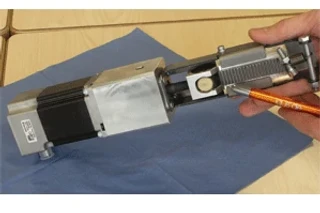
Anti-backlash lead screw nuts in a glue application system of a seam gluing machine (wood industry). These ensure the utmost in precision for the clearance-free adjustment mechanism.
Efficiency
Efficiency is defined as the ratio of output power to input power. DryLin® lead screw nuts are characterized by low friction values and the resulting high efficiencies. Single start trapezoidal lead screw nuts achieve efficiencies between 20 and 48% under dry-running conditions. High helix lead screw nuts achieve efficiencies between 50 and 80% under dry running conditions. Although DryLin® lead screw nuts were developed for completely dry running conditions, lubrication can help to additionally increase efficiency.
Self-locking
Single start trapezoidal lead screw units are self-locking. This means that the flank angle and the sliding friction prevent movement of the nut or the lead screw without the application of outside forces. As soon as the static friction is exceeded, the components are no longer self-locking. Multi-start trapezoidal lead screw units have a "residual self-locking" feature; high helix lead screw units are not self-locking.
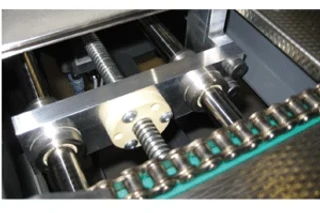
Format adjustment in the paper industry with anti-backlash lead screw nut
Anti-Backlash leadscrew nuts
Backlash refers to the clearance at direction reversal, which is caused in a lead screw unit by the axial clearance. Oscillations and self-induced vibrations (frequently the causes of noise, especially with long lead screws and high RPMs) are significantly reduced by means of radial pre-tensioning using a spring-elastomer.
Zero-Backlash leadscrew nuts
Screw drives with steep thread for quick adjustments of small loads. The zero-backlash system ensures minimal backlash for life. Ideal for precise positioning and feed movements in medical, laboratory and printing engineering and other life-science fields. High-helix nuts without zero-backlash feature or trapezoidal thread should be used for high loads, dirt exposure or extreme external influences.
Zero-backlash lead screw nut assembly
1. Support nut
2. Locking ring with torsion spring
3. Friction disc
4. Axial element
Thread the locking ring approx. half-way onto the support nut 1. using torsion spring 2., and secure the spring tab in the bore.
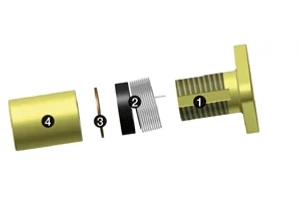
Thread the locking ring to the end of the support nut to tension the torsion spring.
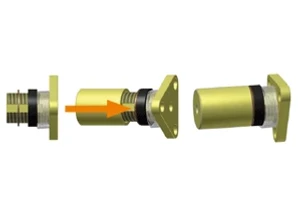
Position the friction disc 3. and the axial element 4. flush against the locking ring. Ensure that the locking ring does not rotate.
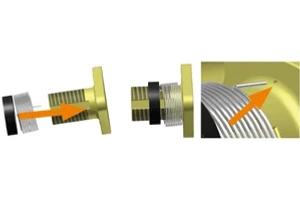
Press together the support nut 1. and the axial element 4. and thread the lead screw through the nut. Pre-tension the locking ring while doing so.
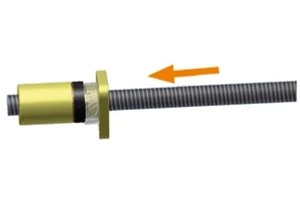
You can now let go of the locking ring, therefore pre-tensioning the nut on the lead screw.

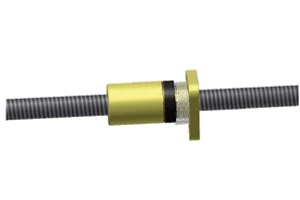
Spindle selection
The usage and operating behavior of the system also depend decisively on the spindles as counter-direction partners. Basically we recommend the purchase of nut and spindle as one system from a single supplier. Spindles are tested with ring gages compatible with DIN 103. Basically the DryLin® trapezoidal lead screw nuts can be used in combination with spindles made of steel, stainless steel or hard-anodized aluminum. "Split" lead screws (right and left-handed threads on one lead screw) are available in addition to right-handed and left-handed versions.
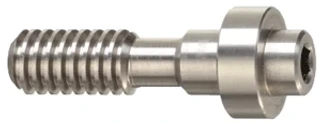
Custom lead screws
Take advantage of our machining service - we manufacture ready to install lead screws based on your needs. Please send us your drawing. We will promptly submit a quote.

Test fixture at the igus® lab to determine service life
Selecting materials
Standard DryLin® lead screw nuts are available in 4 materials:
iglide® J
This material is characterized by the best friction values with the most counter partners and low moisture absorption.
iglide® L280
This material features high static strength.
iglide® A180
This material meets the requirements of the FOOD AND DRUG ADMINISTRATION (FDA) and can therefore be used in direct contact with foods and pharmaceuticals.
iglide® J350
This material features very high resistance to temperatures. Lead screw nuts made from iglide® J350 can be used up to 302 °F.
Table 01: Allowable continuous surface pressure in the threads
| iglide® material | surface pressure |
|---|---|
| iglide® J | 580 psi |
| iglide® L280 | 725 psi |
| iglide® A180 | 508 psi |
| iglide® J350 | 290 psi |
Evaluation: Trapezoidal lead screw
The load capacity of the trapezoidal lead screw nuts made of high-performance polymers is dependent on the surface pressure, the surface speed and the resultant temperature. The temperature behavior is additionally influenced by the duty cycle as well as the selected spindle material and its specific heat conductivity.
Table 02: Surface speeds of the iglide® bearing in m/s
| iglide® material | rotating long-term |
|---|---|
| iglide® J | 1,5 |
| iglide® L280 | 1,0 |
| iglide® A180 | 0,8 |
| iglide® J350 | 1,3 |
Max. allowable pv value
The permitted surface speed and the resultant feed rate for every thread size can be determined with the p x v value and the percentages of the surface contact area stated in the dimensions table.
Table 03: Reference values when using DryLin® plastic nuts without lubrication (with stroke 500 mm). A correction factor may need to be used with very short or long strokes.
| Duty cycle ED | pv-valuemax.[MPaxm/s] |
|---|---|
| 100 % | 0,08 |
| 50 % | 0,2 |
| 10 % | 0,4 |
Required percentage of surface contact area:
Ae = Faxial / ptol [mm2]
Selection of the required thread size and determination of the actual surface pressure:
preal = Faxial / Ae real [MPa]
pv-value:
pv = preal x v
Sliding speed:
v = n x d1 x π/ 60.000[m/s]
Number of revolutions:
n = v x 1.000 x 60 / π x d1 [1/min]
Feed rate:
s = n x P / 60.000 [m/s]
Drive torque:
Mta= Faxial x p / 2000 x π x η
Mte= Faxial x p x η/ 2000 x π
Fig. 05: Formula chart - lead screw units
Faxial = Axial force
Pper = Max. permitted surface pressure 5 N/mm2
preal = Actually occurring surface pressure for selected installation size
Ae real = Percentage of surface contact area of the selected trapezoidal leadscrew nut
P = Lead
d1 = Pitch diameter
Mta = Drive torque [Nm] when converting a rotating motion into a linear motion
Mte = Drive torque [Nm] when converting a linear motion into a rotating motion
v = Sliding speed [m/s]
s = Feed [m/s]
n = Number of revolutions [min-1]
η = Efficiency


